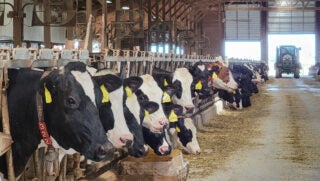As the saying goes, there’s a first time for everything. And by first time, I mean this is my first time spending so much of January wearing short sleeves and listening to the sound of the air conditioner in the background because of the 70+ degree temperatures outside. If this was any other January, my face would be red and chapped from the chill of the wind and my skin would be so dry and cracked that I’d be singing the praises of the makers of O’Keefe’s Working Hands for their one of a kind hand cream formula. Normally, I’d be busy feeding cattle and breaking ice in watering systems with multiple layers of clothing on thanks to Old Man Winter, and I would have already seen a snow flurry or two, at least. Depending on where you’re located, you may be experiencing some of the same odd weather that I am — uncharacteristic and abnormal for the season that we’re in -whether it’s warmer, milder, wetter, colder, snowier, or a combination of these. I think we can all agree that we’ve certainly had no shortage of unusual weather patterns and events as of late across the United States.
It goes without saying that one of the biggest challenges to cattle producers is weather. Some of us are experiencing blizzards while others of us are bracing for tornadoes. Some areas of the country are drought-stricken while others are being pummeled with flooding rainfall. Unfortunately for cattlemen, with extreme or unusual weather conditions (i.e. lots of moisture or very dry conditions) can come the potential for an increased risk of blackleg in cattle.
In layman’s terms, blackleg is a pathogenic and fatal, yet non-contagious disease of muscle tissue that affects young, unvaccinated cattle between 6 months and two years of age. Yes, you read that correctly; it’s not contagious. But because more than one animal is often affected in a herd, there’s sometimes a misconception that blackleg can be spread from one animal to the next. This is not the case. In fact, blackleg is caused by a bacterium that is abundantly present in the soil and environment. The bacterium is known as Clostridium chauvoei, which belongs to a class of organisms known as Clostridia.
C. chauvoei is unique in the fact that it has the ability to form spores, which make soil and the surrounding environment ideal living quarters for the organism in terms of its survivability. The spores are particularly resistant to heat, cold, and other harsh weather conditions, which allow them to live for many years. Cattle usually encounter these spores via ingestion by way of grazing due to contact with the soil’s surface, and this is possible during both wet and dry conditions. Weather events accompanied by lots of moisture can bring the spores to the surface of the soil, potentially in greater concentrations. In addition, cattle that graze pasture grasses, which tend to be shorter in drought conditions, may be at an increased risk of ingesting spores because of more contact with the soil’s surface.
After ingestion, spores have the tricky ability to “hide out” in the animal’s muscle tissue after being transported there by the bloodstream. There, they remain in a latent state (think dormant), waiting until conditions are just right (low oxygen and bruised or damaged tissue) for them to replicate and produce toxins that cause muscle death and subsequent death to the animal. In most cases of blackleg, there is rapid onset of disease and death within 12 to 48 hours.
Symptoms of blackleg in cattle can be similar to those of a wide range of other conditions, as they include lameness, loss of appetite, rapid breathing, fever, and reluctance to move. If you’ve been around cattle for any length of time, you know that pinpointing the underlying health issue based on these “generic” symptoms can be difficult, to say the least. Moreover, clinical signs of blackleg, which include swelling of one or more muscles (usually in the leg, but muscles elsewhere may be affected) can be much harder to notice in cattle unless they’re overwhelmingly obvious, which is oftentimes not the case due to the nature of the disease. One hallmark sign of blackleg worth noting is crackling of the skin when pressed as a result of gas formation in muscle tissue.
As far as treatment procedures go, cattle with blackleg are usually found dead without displaying symptoms or showing signs of illness, since the onset and progression of disease is so quick. However, if suspected and diagnosed prior to death, administration of the appropriate antibiotics by a veterinarian can be done, although it’s often ineffective.
In case you’re wondering, blackleg gets its name from what is observed visually in a post-mortem examination to determine the cause of death. Simply put, muscles, typically in the leg, appear reddish-black in color. I won’t gross you out, so I’ll leave it at that.
I’ve got some good news, though. And that is that blackleg can be prevented through vaccination. I bet you wish I had really hammered this point home at the beginning, huh? If you don’t already have reason enough to vaccinate your cattle against clostridial diseases, add this one to your list. A good vaccination program will not only protect your herd, but can also save you a lot of time, energy, money, and headache in the long run. Go ahead; there’s power in prevention.
Callie Burnett is a farm girl, animal scientist, and biologist whose heritage is deeply rooted in agriculture. She is an alumna of Clemson University with a Master of Science in Animal & Veterinary Sciences.



